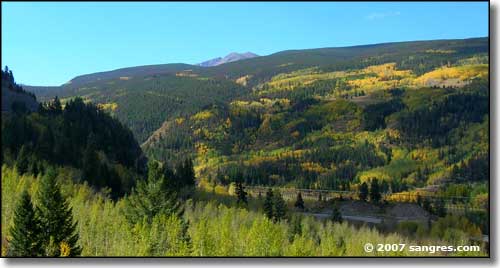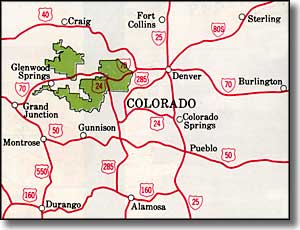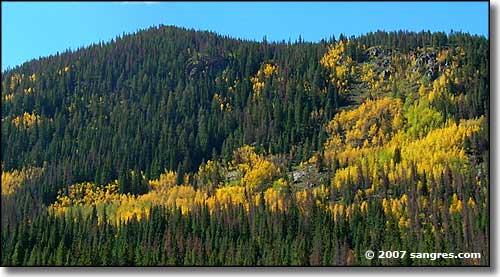
White River National Forest


At approximately 2.3 million acres, the White River is one of the biggest pieces of our National Forest System. With 10 peaks over 14,000 feet, and eight Wilderness areas encompassing more than 750,000 acres, the Forest is also world-reknowned for its scenery.
In October, 1891, the White River Plateau Timberland Reserve, precursor of the White River National Forest, was set aside by executive order of President Benjamin Harrison. The first in Colorado and second in the nation, the reserve covered more than 1.1 million acres. Seven years later, Charles Ramer was appointed the first supervisor. Three rangers were hired and administration began. The White River played host to President Theodore Roosevelt in 1901 while the chief executive hunted mountain lions. Roosevelt went on to reduce the size of the reserve by 61,000 acres in 1902 and 159,000 acres in 1904. Following an Act of Congress in 1905, the name "forest reserves" was changed to "national forests" to indicate that the resources of these areas were not locked up for some distant future.
The White River received its first special designation in 1932, when Chief Forester R.Y. Stuart created the Flat Tops Primitive Area. In 1936, the Forest took its first step to national recognition as a skier's paradise with the proposal for the Hayden Peak ski area. 1946 saw the beginning of Aspen Mountain development with two chair lifts. Skiing on the Forest really took off in the 1960s, as Vail, Snowmass and other areas opened their doors and thousands of skiers opened their wallets, creating some of the most lucrative and growth-intensive recreation areas in the country. The early 1970s brought more growth to the White River, as the Blue River Corridor and Green Mountain Reservoir were added to the National Forest System.
Nowadays, the White River National Forest is the premier National Forest recreation destination in America and hosts more visitors than any other of our country's crown jewels.
When do the aspen colors change?
Changes in Aspen colors usually begin to happen during the last week of September and continue into the first two weeks of October. Times vary every year due to climatic changes and annual moisture levels. This makes it impossible to pinpoint exact dates for catching the best colors.
What about snowfall?
Snow can (and will) fall during almost any month in the Rockies, but in many areas, winter usually sets in sometime between the late part of September and the beginning of November. If you're interested in camping, many campgrounds close for winter. Check out the campgrounds page for seasonal opening and closing dates.
Can I make reservations at campgrounds?
A limited number of campgrounds on the forest can be reserved by calling 1-877-444-6777 but most campgrounds on the forest are operated on a first come, first served basis.
Do I have to have a permit to camp in the National Forest?
No. Camping is allowed in many dispersed areas for free but be sure to pack out all your waste or garbage. Wilderness has entirely different regulations and some wilderness areas on the White River National Forest require permits.
Can I take my "game cart" into Wilderness to retrieve game?
No. The use of mechanized or motorized equipment in Wilderness is prohibited.
What are the regulations concerning ATVs?
ATVs (All Terrain Vehicles) are permitted in certain areas of the forest, however, you must stay on designated roads or trails. These roads are marked on the ground with signs and on forest maps. (You CANNOT use your ATV to go off-road to retrieve game.) Colorado state law requires that all OHVs (Off Highway Vehicles) be registered. If your ATV is not registered in your home state, you must purchase a temporary Colorado registration, available from the Division of Wildlife, any State Park Office or local sporting goods store.
Is there a problem with bears on the White River?
Reports of agressive bears are few and far between but you should always take the necessary precautions when camping in bear country. Always keep a clean camp; don't leave food out, store it in bear resistant storage containers, in your vehicle or hang it in a tree at least 10 feet above the ground and away from the trunk of the tree. Set tents in a series with spaces between and sleep well away from your cooking area. Don't keep the clothes you cooked or handled fish in inside the tent while you sleep. Keep bear pepper spray readily available. (And don't bother with the silly little bells, the bears will just have a good laugh as they chew them up.)
What maps are available and how do I purchase them?
White River National Forest maps are available from any district office for a small fee. Most offices also carry 7.5 min USGS topo maps which cover broad areas accurately. Many sporting goods stores in Colorado carry a good supply of local USGS maps. Maps can also be purchased with a credit card from the Supervisors Office in Glenwood Springs, Colorado by calling 970-945-2521.

